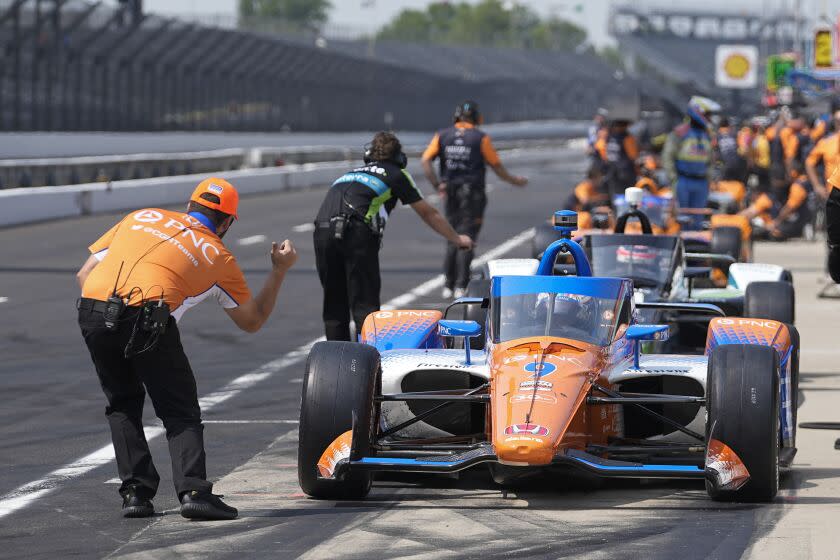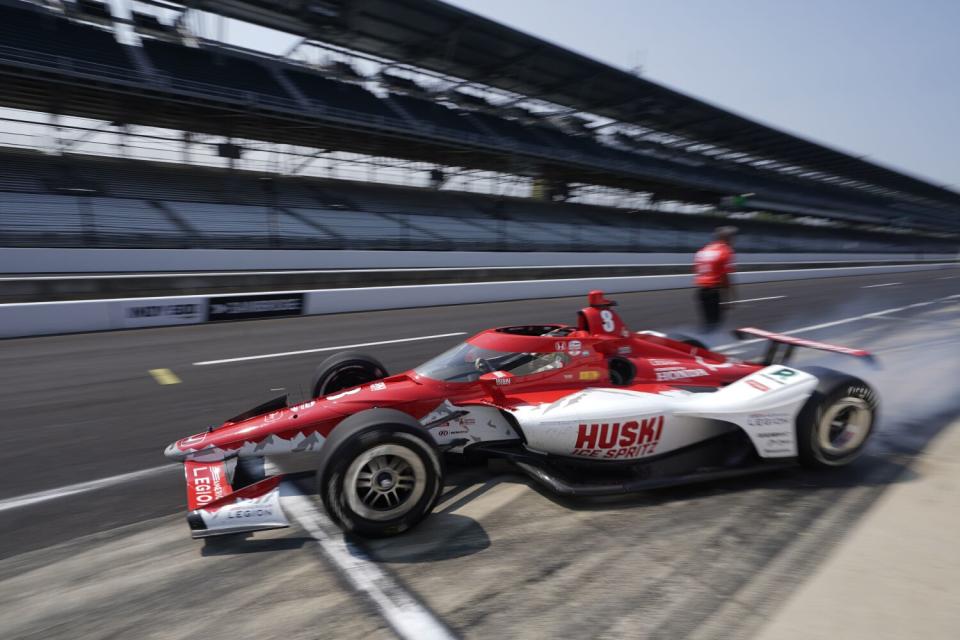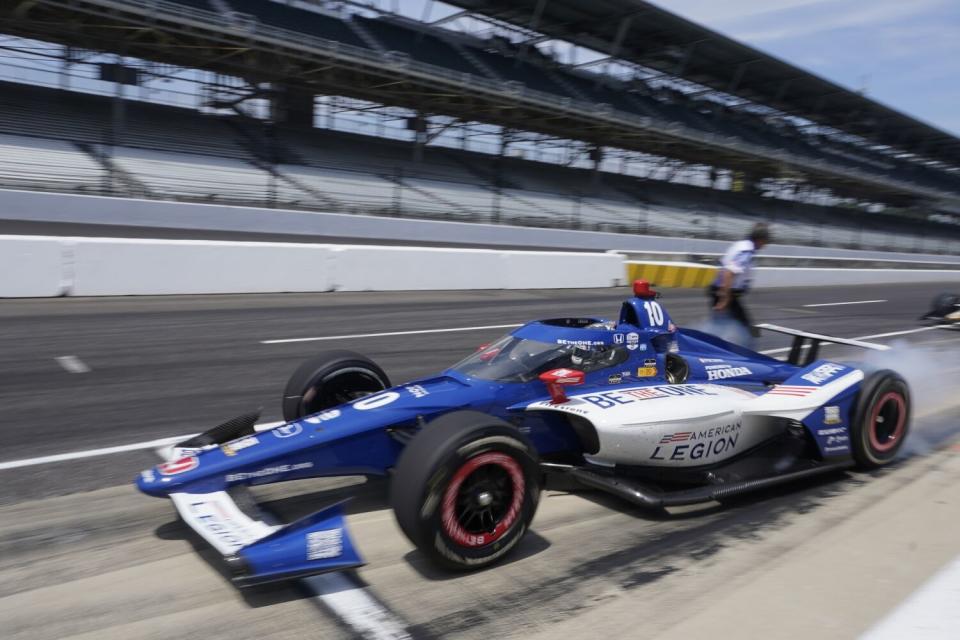How IndyCar and its partners are pioneering use of green technology

Ray Harroun forever changed the nascent sport of auto racing — and by extension, auto driving — when he steered his mustard-yellow car to the starting line for the first Indianapolis 500. His single-seat racer was revolutionary in virtually every aspect, from the narrow, tapered fuselage to the six-cylinder engine, which is why he won that 1911 race in a rout.
However the most intriguing aspect of the design, the mirror Harroun mounted on the struts of his car, vibrated so violently on the brick racetrack it did him no good at all. So designers returned to the drawing board, modified the rear-view mirror and drivers have been looking back ever since.
For more than a century, motorsport has been a fertile testing ground for automotive technology, with race teams perfecting disc brakes, carbon-fiber construction, push-button ignition and suspension systems — all advances that have made the transition from the racetrack to passenger cars. But in recent years the IndyCar Series, which returns to the iconic brickyard on May 28 for the 107th Indianapolis 500, has stepped up its game, adopting a collection of practices designed to make racing more eco-friendly, among them the use of alternative fuels, sustainable rubber for tires, electric-powered tools, even diesel for the 18-wheelers that haul racecars across the country.
“We’ve always been about innovation,” said Mark Sibla, IndyCar’s chief of staff. “And so I think we see this as another step in that. We want to be a good corporate citizen. And to be able to use innovation to be a good corporate citizen, and in some instances actually improve the product, it’s a win-win for everybody.”
That double victory has IndyCar ahead of the curve in terms of green-energy advances in motorsport. This year it became the first U.S.-based racing series to use 100% renewable race fuel, powering its cars with second-generation ethanol derived from sugarcane and developed as part of a joint venture between Shell and Raizen, a major Brazilian fuel distribution company. The latest changes come at a time when all auto racing series have increasingly found themselves in the crosshairs of activists warning about the effects of global warming caused by the burning of fossil fuels.
Four years ago Jean Todt, then FIA president, challenged his series to become a net-zero carbon polluter by 2030, warning that the existence of international motorsports were threatened by the impact it has on the environment. And while the IndyCar policies aren’t that ambitious, they are significant.
“It’s something that we’ve identified as being very important," Sibla said. “... We’ve had, certainly, a lot of discussions internally about what are some new technology that we can introduce. Everyone has embraced the topic.”
“It’s about using that influence in a positive manner,” he continued. “Our fans love innovation, they love technology. This is a great way that we can bring it in and some good things along that path.”

Perhaps the most important advance is taking place where the rubber meets the road, with Firestone developing tires made from sustainably sourced materials. And with each race team going through at least 20 four-tire sets during each of the 17 stops on the IndyCar series — or more than 34,000 Bridgestone racing tires per season — that is already making a huge difference.
“Nothing goes into a landfill,” said Cara Krstolic, the director of race tire engineering and manufacturing for Firestone, which has been working on a renewable tire for more than a decade. Instead of sourcing the material from rubber trees in Southeast Asia, the new tires, which debuted last August at the Music City Grand Prix in Nashville, are made from guayule, a shrubby low-water-use plant found in the deserts of the southern U.S. and northern Mexico.
Drivers, Krstolic said, are happy with the way the green-sidewall tires have performed.
“The best compliment we could get is we saw no difference in the tires,” she said. “We are investing in sustainability at Bridgestone, not because it’s fun and not just because it’s something [people] can talk about. We love racing. And we want to be in racing for a very long time.
“In order to do that we need to become a more sustainable series.”
That’s also driving Shell’s work on a 100% renewable racing fuel that, the company says, reduces greenhouse gas emissions by 60% compared to fossil-based gasoline.
“Shell has set a target to become a net-zero energy company,” said Bassem Kheireddin, the company’s motorsports technology manager. “We’ve put together several measures around reducing, offsetting and maybe eliminating in some cases [greenhouse gas emissions]. It’s about reducing the carbon footprint and also the use of a fuel that is made from renewable components.”
And just as Firestone hopes to take its new tire technology from racing to the consumer market, Shell believes its new fuel will someday be available at the pump as well.
“This is a prime example of how pushing the boundaries on the racetrack can benefit our consumers and customers around the world in the future. The fuel requirements for a racing engine is different than that of a passenger car. However the learning from the track can be used in our road-going product,” Kheireddin said.
“Indy has always been a proving ground,” Sibla added. “That’s one of the fantastic benefits of racing. You put something in a harsh, aggressive environment, a racetrack, and you prove it out. Then over time it gets refined and it can be, in some cases, introduced to the commercial audience.
“This is a test lab where new technologies are introduced.”

The drive toward sustainability extends beyond race day. Styrofoam cups and single-use cutlery have been banned from IndyCar’s corporate office in Indianapolis, for example, and the haulers that move race teams across the country — driving many times farther than the race cars — run on diesel, which produces a fraction of the emissions of gasoline.
“Obviously we have a platform here. We have a responsibility to promote sustainability,” said Tim Baughman, IndyCar’s senior director of track safety. “And we need to be good stewards of that. I think that’s our role.”
Not everyone is as convinced. Robert Clarke, the president and CEO of Clarke-Works, a motorsport consulting business, and a former executive at Honda Performance Development, says IndyCar hasn’t moved quickly nor aggressively enough to address green-energy innovation.
“IndyCar has barely evolved,” he said. “Burning corn-based ethanol and using tires that are made from eco-friendly guayule materials are good, but rather token steps. And the hybrid electric system they’ve delayed multiple times will be another token/symbolic gesture when introduced.”
Despite its history of technical innovation — and IndyCar’s recent advances — most motorsport series have been late to adopt eco-friendly technologies, oftentimes following in the wake of governments and other industries. And the motivation for even that small evolution hasn’t been strictly altruistic. As Todt warned, concerns over global warming and the effect automobiles are having on climate change is threatening the viability of auto racing.
Before the pandemic — and before “Formula 1: Drive to Survive,” the popular behind-the-series Netflix docuseries now in its fifth season — motorsport was dying, Clarke said.

“The audience was an aging audience that was literally dying off,” he said. “Series are starting to understand and appreciate that they have to be more to the fans than just running cars around circles on the racetrack.”
Increasingly that means initiatives making a greater impact than most IndyCar has adopted. Think technologies not currently in play such as super-light motors and batteries and ultra-fast wireless charging in the pits or continuously from the track.
A move toward electric or emissions-efficient hybrid alternative-energy cars, for example, has already begun. There are currently more than a dozen series for electric-powered vehicles led by Formula E, the highest class of racing for electric single-seat race cars. That series, conceived in 2012, has made significant progress in terms of battery power and performance in recent years and saw its Formula E Championship reach FIA status in 2021.
Sibla said there are no plans for an all-electric Indy 500 in the near future — although he wouldn’t rule that out either. Innovation, after all, is what motorsport is about, whether it’s a rear-view mirror or a battery-powered racecar.
“I don’t know that we can answer that yet, to say, ‘Where is it headed?’” he said. “You have a 500-mile race and right now electric technology would make that exceptionally difficult. There could be other technologies that are produced in the future. We could continue to utilize the 100% renewable fuel that Shell’s introducing next year. It could go in a different direction.
“We’re looking at a multitude of different areas. What are the new technologies that are coming out? What can help improve the product. That’ll help direct us there.”
A century ago, Harroun found a way for Indy drivers to look behind them. But now the series is all about looking ahead.
This story originally appeared in Los Angeles Times.

 Yahoo Sports
Yahoo Sports 